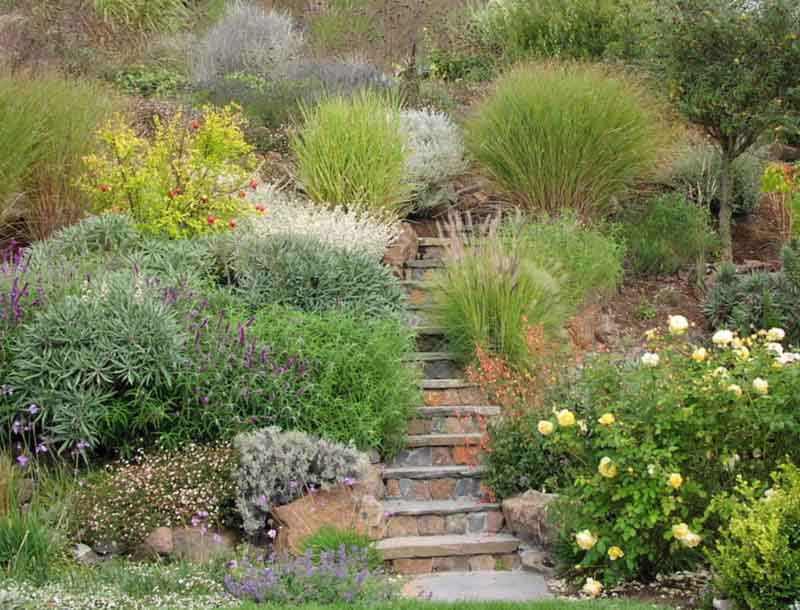Top ideas for Steep hill landscaping without erosion issues.
Top ideas for Steep hill landscaping without erosion issues.
Blog Article
Accomplish an Attractive Outdoor Oasis With Thoughtful Steep Hill Landscaping Solutions
Transforming a steep hillside into an exciting outside oasis presents one-of-a-kind difficulties that call for ingenious landscape design solutions. By dealing with concerns such as disintegration control and accessibility, one can produce a harmonious blend of charm and performance. Techniques such as terracing, the setup of maintaining wall surfaces, and the choice of indigenous plants play crucial duties in this process. In addition, integrating water attributes can further boost the landscape's attraction. Nevertheless, understanding the ins and outs of these components is necessary for accomplishing a genuinely cohesive and welcoming environment. What techniques will best suit your hill's certain qualities?
Understanding Steep Hill Challenges
Landscaping on high hillsides provides unique obstacles that need careful consideration and tactical preparation. The inclination of the terrain can result in issues such as dirt disintegration, water overflow, and minimal availability, all of which have to be dealt with to create a useful and aesthetically pleasing exterior space.
Among the main issues with high hill landscape design is erosion, which can result from hefty rainfall or inappropriate drainage. This not only impacts plant wellness however can also jeopardize the security of the incline. Executing reliable erosion control procedures, such as growing ingrained plants or making use of mulch, is essential in preserving the integrity of the landscape.
:max_bytes(150000):strip_icc()/101348559a-6fa8b850245448f1889556082338b7c1.jpg)
Creating With Terracing Strategies
To minimize the challenges presented by high hillsides, incorporating terracing methods can be an effective option. This design method transforms a sloped landscape into a series of flat, level areas, producing an aesthetically striking and functional exterior area. Terracing not only aids to avoid soil erosion but likewise helps with better water drainage, which is essential in preserving the health and wellness of plants and the security of the hill.
The use of native plants on each level can boost biodiversity, promote sustainability, and lower maintenance needs. Furthermore, including pathways between terraces can enhance accessibility and motivate expedition of the landscape.
Terraced gardens can serve numerous objectives, including vegetable production, ornamental display screens, or outdoor seating areas. By using products that blend sympathetically with the surrounding setting, the terracing can enhance the overall aesthetic allure of the building. Eventually, thoughtful terracing changes high hillsides right into functional, stunning areas that welcome communication and satisfaction.
Applying Preserving Walls
When confronted with the difficulties of high surface, applying preserving wall surfaces can offer both structural support and visual improvement to a landscape. These wall surfaces serve to avoid dirt erosion, maintain slopes, and produce flat locations for gardening or entertainment use. Steep hill landscaping. By efficiently taking care of water runoff and lowering soil movement, preserving walls secure your landscape investment while enhancing safety

Professional installation is critical to guarantee the news longevity and performance of preserving walls. Appropriate water drainage systems must be integrated to relieve hydrostatic pressure, protecting against structural failure. Consulting with landscape experts will certainly make certain that the design aligns with your general vision while adhering to neighborhood regulations.
Picking Native Plants
Choosing native plants for your landscape design provides countless eco-friendly and visual benefits. Steep hill landscaping. Native plants are adjusted to the local climate and soil conditions, calling for less water and maintenance contrasted to non-native species. This adaptability not just preserves resources but additionally promotes a healthier ecosystem, as indigenous plants sustain local wild animals, consisting of pollinators such as bees and butterflies
Integrating native flora right into your high hillside landscaping can improve dirt security, reducing disintegration and promoting a balanced ecological community. Ingrained native plants help anchor the dirt, making them excellent for sloped areas. Additionally, click this these plants typically exhibit vivid colors and varied structures, producing a visually attractive landscape that balances with the surrounding environment.
When choosing indigenous plants, consider their development practices, seasonal rate of interest, and compatibility with other types. Grouping plants with similar water and sunlight needs can cause a much more cohesive layout, while likewise simplifying maintenance. By choosing indigenous plants, you not only cultivate a sustainable exterior sanctuary however also add positively to the neighborhood biodiversity, making certain that your landscape thrives for many years to come.
Incorporating Water Functions
Incorporating water features right into your high hillside landscape design can significantly improve both the aesthetic charm and eco-friendly capability of the space. The sound of moving water creates a serene ambience, while aesthetically, it can act as a prime focus that attracts the eye and adds deepness to the landscape.
When selecting water features, think about alternatives that complement the all-natural shapes of your hill. Waterfalls, as an example, can cascade down the incline, developing aesthetic interest and advertising healthy and balanced water drainage. Fish ponds can likewise be integrated right into the design, encouraging neighborhood wildlife and supplying environments for different varieties.
Additionally, the positioning of plants around these features is critical. Native water plants not only enhance the charm of the water feature yet likewise add to its eco-friendly balance by filtering toxins and supplying food for neighborhood fauna.
Upkeep is an additional vital element; ensure that your water attribute is developed for very easy upkeep. An appropriately built feature will certainly require very little intervention, enabling you to delight in the beauty and tranquility it provides without excessive labor. Eventually, thoughtfully incorporated water attributes can transform your steep hillside landscape into an exciting exterior sanctuary.
Final Thought
In verdict, transforming a steep hillside into a lovely outside oasis requires thoughtful landscaping methods that resolve erosion control and ease of access. The combination of terracing methods, the implementation of retaining walls, and the choice of indigenous plants are crucial elements of effective style. In addition, integrating water attributes Go Here improves both visual charm and drain effectiveness. With mindful preparation and execution, steep hills can come to be calm retreats that offer both functionality and visual joy.
Report this page